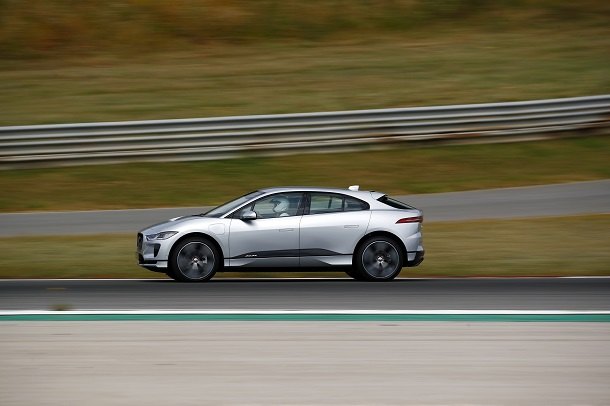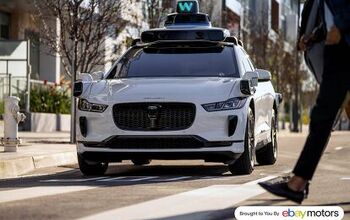2019 Jaguar I-Pace First Drive - Electric Avenue Now Has More Traffic
Editor’s Note: This article is written by contributor Jeff Taylor. Due to technical difficulties, it is under the TTAC Staff byline. Once those difficulties are fixed, Jeff’s name will be properly attached.
Jaguar’s new I-Pace EV is the first vehicle in the automaker’s plan to fully electrify — or electrically assist — all of its vehicles beginning in 2020.
The I-Pace raises the question: can Jaguar’s EV powertrain live up to everyday driving demands and deliver the premium experience luxury buyers demand without a huge power-suck mileage penalty?
Additionally, mainstream and luxury manufacturers have announced aggressive electrification plans of their own, which puts more heat on Jaguar to get it right or risk its plug being pulled.
To gauge Jaguar’s level of success, I spent some time in Lisbon, Portugal for the I-Pace Media Drive. During the launch program, I put the I-Pace through some tough driving situations and made some surprising discoveries about both the vehicle and what it means for the industry moving forward.
Full disclosure: Jaguar flew me to Lisbon, Portugal and covered my luxury hotel accommodations and meals. They also provided track time at Autodromo Internacional Algarve racecourse in Portugal. I was also offered a European electric outlet plug converter, which I did take, and an I-Pace coffee table hardbound book, which I did not keep.
I-Pace is the first legitimate challenger to Tesla’s Model S hatchback and Model X SUV. Tesla has been the poster child for luxury electric vehicles for several years, but a string of delays/high-profile incidents/corporate layoffs have tattered that poster. Jaguar has the benefit of fortuitous timing for the launch of its version of what a premium, all-wheel-drive, midsize crossover EV can be.
Walk up to the 2019 I-Pace and you’ll notice the low roof height, styling bends, kinks, pop-out door handles, vents, and diffuser. All are there for air management purposes and look good on the curvaceous body. The rear is abrupt to provide maximum aero efficiency. Large 20-inch tires (22’s are available) fill wheel openings and provide an aggressive contact patch. The “cab-forward” design, combined with a long wheelbase and short overhangs, gives I-Pace an athletic blend of crossover/sedan/wagon that differentiates it from oddball-styled EVs. During the drive, I received lots of admiring glances and head nods. Goodbye geek, hello chic.
The battery design is a big reason why this vehicle exists. It’s a big lithium-ion pack with a nickel, manganese, and cobalt composition. It’s heavy, so engineers designed the battery to tuck below the floor and become an integral part of the platform, improving the vehicle’s center of gravity and maximizing interior space. The result is a nearly neutral 50/50 weight balance.
The other powertrain story is the Jaguar-designed dual e-motors powering both the front and rear axles. The motors are synchronous permanent magnet units linked to a continuously variable automatic transmission. Total system output is robust at 394 horsepower and 512 lb-ft of torque. Towing is not an option, but a bike carrier and roof rack are.
Fire up the I-Pace and there’s nothing, no shudder, vibration or roar of a combustion engine. The dash lights up, accompanied by a brief hum, as the car becomes “energized.” Pulling out into a crowded street, the I-Pace felt and behaved like previous EVs I’ve tested. Adjustable, regenerative braking enables single-foot driving, meaning I could keep my foot off the brake pedal and still slow down. Regenerative braking can be set for lighter or firmer application and activates the brake lights when in use.
I-Pace’s double-wishbone front suspension is cribbed from the F-Type, and at the rear, there’s a modified version of the integral-link suspension employed in E-Pace and F-Pace. The suspension is adjustable with Comfort, Dynamic and Eco modes. I-Pace can go “low-rider” via an optional height-adjustable air suspension that drops it 1.6 inches. An additional 0.4-inch drop occurs at speeds in excess of 65 mph for more drag relief. You can also raise I-Pace 2.0 inches for off-road and water crossings – more on that later.
Mash the juice pedal in Dynamic mode and you’re pushed deeply into the seatback. Jaguar claims a 0-60 time of 4.5 seconds. I was impressed by the acceleration, immediate response and smooth takeoff – no noise, body shake or gear changes.
After buzzing down the highway out of Lisbon, we ventured up into the mountains. It was there that I learned how capable and responsive I-Pace is. Charging up the mountain roads, taking corners at an aggressive clip, my co-driver and I kept pushing the I-Pace. We were able to toss it deep into corners confidently, using regenerative braking to scrub speed entering turns and hairpin corners, then power out as quickly as we would in any current premium sports sedan.
When the pavement ended, I gave the car a bath. Using the adjustable height setting, AWD and low speed I (intentionally) put an electric vehicle in a stream that was nearly two feet deep and full of small rocks. Then, upon exit, it was straight up a very steep and long hillside with minimal wheel spin or rock inference.
The final part of our drive involved hot laps of the Autodromo Internacional Algarve racecourse. This challenging 15-turn track allowed us to blast down the short front stretch approaching speeds of 120 mph (124 mph is the vehicle’s top speed). The I-Pace carved up corners as well as most sports sedans, exhibiting minimal body lean, brake fade, or excessive suspension unloading. There was some slight understeer and late braking lead to some heart-stopping moments, but the overall buzz from the pampered press was positive.
So, about that mileage range – I’m not a believer in manufacturer EV range claims, as I’ve nearly been stranded several times. Jaguar cites a 240-mile range and I believe that figure is achievable through meticulous driving and favorable weather conditions. However, 200-215 miles is more likely. A 100kW DC fast charger provides roughly an 80 percent charge in about 40 minutes. Buy a 7kW wall box charger for your garage and Jaguar indicates it will take almost 13 hours to fully charge a depleted battery.
Inside I-Pace I was greeted by a massive protruding dash housing large digital gauges behind a grippy steering wheel. Two screens dominate the center of the dash: A 10-inch touchscreen up top, and a 5-inch screen below. The latter displays infotainment via the menu-heavy Touch Pro Duo system. Dials with mini readout screens for HVAC and audio control are also used.
The navigation system employs artificial intelligence so I-Pace can learn your driving style. Beyond directions, I used it for a projection of my remaining mileage range. It can also program a drive route around charging stations – very handy.
The leather seats are very comfortable during aggressive driving (excluding second row center position) and comfortable for normal drives. The flat floor provided excellent foot/leg room and rear seating is good for four. Above your head is a roof comprised of a solid UV coated (non-shade) piece of tinted glass — it looks cool — but I question its crashworthiness. My other interior gripe concerns the short sun visors that don’t stretch the length of the front passenger windows to block the late afternoon sun.
As I-Pace is a crossover, it has to be able to carry something. The luggage compartment holds 25.3 cubic feet second row up, and 51.0 cubic feet with the second row folded flat.
At launch late this summer, I-Pace will be offered in four trim levels: S, SE, HSE and First Edition. During the program I drove a fully loaded S ($69,500 base, $82,885 as tested) and a red First Edition ($85,900 base, $88,595 as-tested) models. The as-tested pricing included the $995 destination and delivery charge. There’s quite a spread between S and HSE models, mainly in equipment, but not in looks.
Available equipment includes leather seats, blind-spot assist, adaptive cruise control with stop and go, high-speed emergency braking, heated and cooled front seats, heated rear seats, power tailgate (power gesture tailgate also available), heated steering wheel, front fog lights, four-zone climate control, premium audio, 360-degree camera, activity key, adaptive cruise control with steering assist, and head-up display.
Jaguar has now upped the standard for luxury and non-luxury EVs with its I-Pace. This SUV/sports car combination is not perfect, but it hits the sweet spots of robust acceleration, athletic handling, and a roomy, luxurious interior. I’m a muscle-car aficionado raised on “there’s no substitute for cubic inches” mantra, and I never thought I would be impressed by the performance of a production EV. I-Pace previews the direction and expectations that cars and crossovers will take in the future.
[Images © Jaguar/Land Rover USA]
More by Jeff Taylor
Latest Car Reviews
Read moreLatest Product Reviews
Read moreRecent Comments
- FreedMike Not surprisingly, I have some ideas. What Cadillac needs, I think, is a statement. They don’t really have an identity. They’re trying a statement car with the Celestiq, and while that’s the right idea, it has the wrong styling and a really wrong price tag. So, here’s a first step: instead of a sedan, do a huge, fast, capable and ridiculously smooth and quiet electric touring coupe. If you want an example of what I’m thinking of, check out the magnificent Rolls-Royce Spectre. But this Cadillac coupe would be uniquely American, it’d be named “Eldorado,” and it’d be a lot cheaper than the $450,000 Spectre – call it a buck twenty-five, with a range of bespoke options for prospective buyers that would make each one somewhat unique. Make it 220 inches long, on the same platform as the Celestiq, give it retro ‘60s styling (or you could do a ‘50s or ‘70s throwback, I suppose), and at least 700 horsepower, standard. Why electric? It’s the ultimate throwback to ‘60s powertrains: effortlessly fast, smooth, and quiet, but with a ton more horsepower. It’s the perfect drivetrain for a dignified touring coupe. In fact, I’d skip any mention of environmental responsibility in this car’s marketing – sell it on how it drives, period. How many would they sell? Not many. But the point of the exercise is to do something that will turn heads and show people what this brand can do. Second step: give the lineup a mix of electric and gas models, and make Cadillac gas engines bespoke to the brand. If they need to use generic GM engine designs, fine – take those engines and massage them thoroughly into something special to Cadillac, with specific tuning and output. No Cadillac should leave the factory with an engine straight out of a Malibu or a four-banger Silverado. Third step: a complete line-wide interior redo. Stop the cheapness that’s all over the current sedans and crossovers. Just stop it. Use the Lyriq as a blueprint – it’s a big improvement over the current crop and a good first step. I’d also say Cadillac has a good blend of screen-controlled and switch-controlled user interfaces; don’t give into the haptic-touch and wall-to-wall screen thing. (On the subject of Caddy interiors – as much as I bag on the Celestiq, check out the interior on that thing. Wow.)Fourth step: Blackwing All The Things – some gas, others electric. And keep the electric/gas mix so buyers have a choice.Fifth step: be patient. That’s not easy, but if they’re doing a brand reset, it’ll take time.
- NJRide So if GM was serious about selling this why no updates for so long? Or make something truly unique instead of something that looked like a downmarket Altima?
- Kmars2009 I rented one last fall while visiting Ohio. Not a bad car...but not a great car either. I think it needs a new version. But CUVs are King... unfortunately!
- Ajla Remember when Cadillac introduced an entirely new V8 and proceeded to install it in only 800 cars before cancelling everything?
- Bouzouki Cadillac (aka GM!!) made so many mistakes over the past 40 years, right up to today, one could make a MBA course of it. Others have alluded to them, there is not enough room for me to recite them in a flowing, cohesive manner.Cadillac today is literally a tarted-up Chevrolet. They are nice cars, and the "aura" of the Cadillac name still works on several (mostly female) consumers who are not car enthusiasts.The CT4 and CT5 offer superlative ride and handling, and even performance--but, it is wrapped in sheet metal that (at least I think) looks awful, with (still) sub-par interiors. They are niche cars. They are the last gasp of the Alpha platform--which I have been told by people close to it, was meant to be a Pontiac "BMW 3-series". The bankruptcy killed Pontiac, but the Alpha had been mostly engineered, so it was "Cadillac-ized" with the new "edgy" CTS styling.Most Cadillacs sold are crossovers. The most profitable "Cadillac" is the Escalade (note that GM never jack up the name on THAT!).The question posed here is rather irrelevant. NO ONE has "a blank check", because GM (any company or corporation) does not have bottomless resources.Better styling, and superlative "performance" (by that, I mean being among the best in noise, harshness, handling, performance, reliablity, quality) would cost a lot of money.Post-bankruptcy GM actually tried. No one here mentioned GM's effort to do just that: the "Omega" platform, aka CT6.The (horribly misnamed) CT6 was actually a credible Mercedes/Lexus competitor. I'm sure it cost GM a fortune to develop (the platform was unique, not shared with any other car. The top-of-the-line ORIGINAL Blackwing V8 was also unique, expensive, and ultimately...very few were sold. All of this is a LOT of money).I used to know the sales numbers, and my sense was the CT6 sold about HALF the units GM projected. More importantly, it sold about half to two thirds the volume of the S-Class (which cost a lot more in 201x)Many of your fixed cost are predicated on volume. One way to improve your business case (if the right people want to get the Green Light) is to inflate your projected volumes. This lowers the unit cost for seats, mufflers, control arms, etc, and makes the vehicle more profitable--on paper.Suppliers tool up to make the number of parts the carmaker projects. However, if the volume is less than expected, the automaker has to make up the difference.So, unfortunately, not only was the CT6 an expensive car to build, but Cadillac's weak "brand equity" limited how much GM could charge (and these were still pricey cars in 2016-18, a "base" car was ).Other than the name, the "Omega" could have marked the starting point for Cadillac to once again be the standard of the world. Other than the awful name (Fleetwood, Elegante, Paramount, even ParAMOUR would be better), and offering the basest car with a FOUR cylinder turbo on the base car (incredibly moronic!), it was very good car and a CREDIBLE Mercedes S-Class/Lexus LS400 alternative. While I cannot know if the novel aluminum body was worth the cost (very expensive and complex to build), the bragging rights were legit--a LARGE car that was lighter, but had good body rigidity. No surprise, the interior was not the best, but the gap with the big boys was as close as GM has done in the luxury sphere.Mary Barra decided that profits today and tomorrow were more important than gambling on profits in 2025 and later. Having sunk a TON of money, and even done a mid-cycle enhancement, complete with the new Blackwing engine (which copied BMW with the twin turbos nestled in the "V"!), in fall 2018 GM announced it was discontinuing the car, and closing the assembly plant it was built in. (And so you know, building different platforms on the same line is very challenging and considerably less efficient in terms of capital and labor costs than the same platform, or better yet, the same model).So now, GM is anticipating that, as the car market "goes electric" (if you can call it that--more like the Federal Government and EU and even China PUSHING electric cars), they can make electric Cadillacs that are "prestige". The Cadillac Celestique is the opening salvo--$340,000. We will see how it works out.









































Comments
Join the conversation
Nothing in that SUV says "I am EV". It looks like any other evil gas powered jaguar. Tesla on the other hand is immediately recognized as EV.
Continuously variable automatic transmission? No, probably not. This is arguably less awkward looking but than a Model X but also less useful (the curse of sporty CUVs vs minivan-like CUVs). It's not much less expensive, particularly given that the base price doesn't include things you'd assume a luxury car would have like leather and blind spot monitoring. It doesn't come with any assurance of better quality. It doesn't come with a bigger dealer network. I'm struggling to see its advantage. But its disadvantage is plain to see: no Supercharger network. Telsa has a massive, dedicated fast charge network, it's faster than any actually-existing competitive system, and it's integrated into the navigation route planning. Jaguar has no charging network, no integrated route planning, and its fast-charge claims are based on 100kW chargers that effectively don't exist: most actually existing non-Tesla fast chargers are 24 or 50 at best, vs ~120 for Tesla. Nobody would buy gas cars if it was hard to find a gas station, and when you found one there was a half hour wait for the other guys to finish filling up, and then the hose didn't fit your filler neck, and might randomly get dinged for four times what the last fillup cost, and it might be randomly be way faster or way slower than the last fillup. This is the problem facing LITERALLY EVERY OTHER MANUFACTURER EXCEPT TESLA. If you build out the charging network, they will come. If you don't, you're building luxuriously appointed second cars at best. That's a market, but it's not the future.